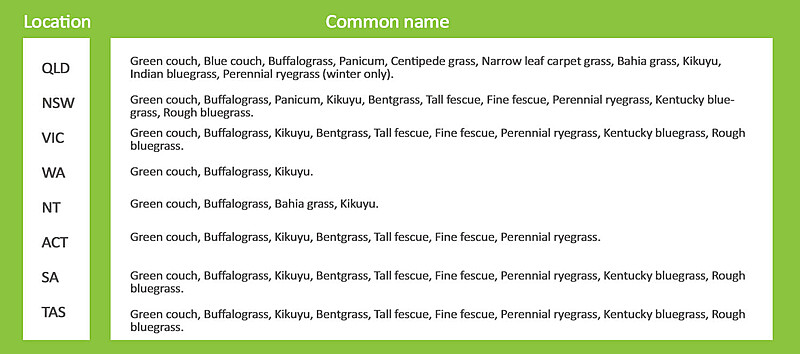Nearly 10% of all new lawns are established by seed. New and improved species and varieties are continually being developed and released by overseas and Australian organisations. Lawn seed provides an alternative to vegetative turf and is well suited for smaller applications, repair work and where budget constraints may exist. It is important to know about what seed you are purchasing and if it is suitable to meet your needs and environmental conditions.
Much of the lawn seed sold commercially within Australia by retail stores are blends containing greater than 85% cool-season grass species. The names on the well branded packages do not normally indicate what the species mix is and may actually claim a deceptive range of climatic adaptation. A species list, using either common or scientific name, will normally be shown in smaller print somewhere on the back or side of the packet. This information is very important in knowing what you are purchasing and ultimately how the seed will perform in your environment.
It is surprisingly common for temperate or cool-season climate grass species to be found in lawn seed blends. Success will be dependent on the growing environemtn and season. For example, within Queensland seed may germinate, but the seedlings may not persist in QLD's warm climate if the seed packet contains cool-season grass species. Any long-term success with such blends in Queensland will be attributable to the presence of usually smaller quantities of warm-season turfgrass species present within the packet e.g. green couch or kikuyu.
Purchased seed may be hulled or unhulled or a mixture of both. Hulled seed germinates faster, but is more expensive.
The purity percentage shows how much of the material in the packet consists of seeds of the labelled species, the remainder being inert material or other seeds. The germination percentage then tells you how many live seeds there are in the pure seed fraction. For example, a minimum 98 percent purity and 75 percent germination means that the seed company claims that there is a maximum of 2% inert matter and other seeds present, and that at least three quarters of the seeds are viable.
Some varieties of seed are coated to provide improved plant protection, vigor and performance. The coating comes in a range of colours depending on the manufacturer and their point of difference. Coating has the ability to apply fertiliser, insecticides, fungicides and or absorbent technology to the seed to help with germination and growth during the establishment period.
Below is a list of seeded turf species highlighting their favoured geographic growing conditions, by states and territories, across Australia. Be sure to check the packet to see what you are really purchasing. Refer to our 'turf species difference' page for further information on each grass type.

For information on seed establishment and care, for new lawns, please refer to our site preparation, planting and after planting care pages.
Overseeding is a term used for oversowing seed into an existing or established turfgrass. For example, applying ryegrass seed over an established green couch or hybrid couch lawn. Such a practice is common during the cooler months in the year in temperate and subtropical environments. This is largely for aesthetics, however in a sporting field, the practice may be essential to maintain suitable grass cover during the winter playing season.
Prior to overseeding it is recommended, but not essential, to apply a Plant Growth Regulator, to supress turf growth of the established turf. This is because, additional watering is required (for the first 7 to 14 days, with 2 to 4 short cycles per day to keep the seed and ground moist) to establish the seed and routine mowing is not possible. Mowing can commence 1 to 2 weeks after seed germination.
Following the application of seed, a turf starter granular fertiliser can be applied. Foliar or liquid fertiliser applications to improve root development can also be applied once the seed has germinated. Supplementary granular fertiliser should be applied approximately 4 weeks after seeding.